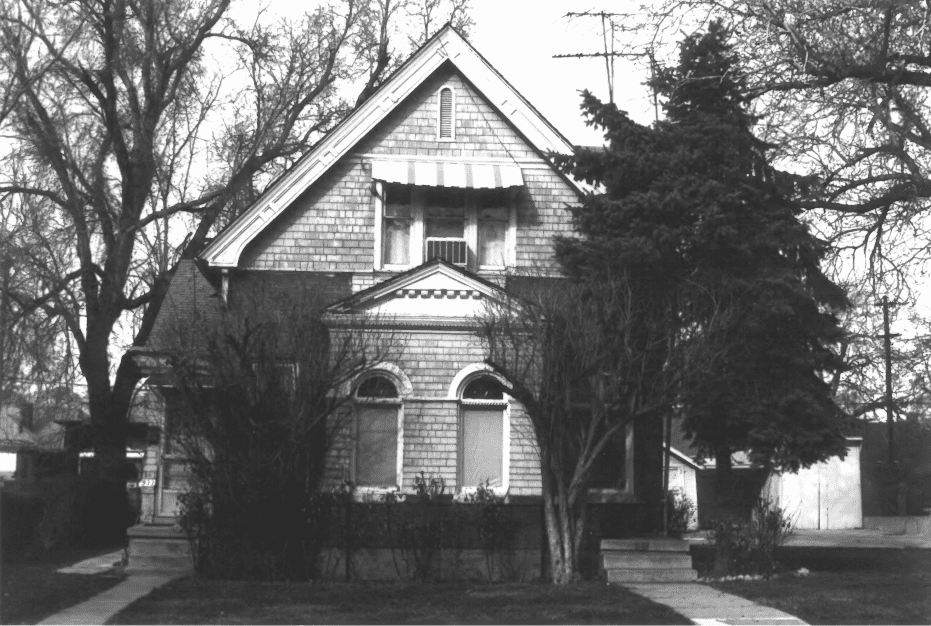
Located at 935 East Logan Avenue in the Perkins Addition in Salt Lake City, Utah and added to the National Register of Historic Places (#83003959) on October 13, 1983. The text below is from the nomination form for the national register.
The Charles H. Weeks House, built in 1891, is architecturally and historically significant as one of the ten remaining houses that were original to Perkins’ Addition subdivision, the most visually cohesive example of a streetcar subdivision in Salt Lake City. Streetcar subdivisions played a major role in the transformation of the land south of the original city from agricultural to residential use in the 1890s, and Perkins Addition was considered the standard of subdivision excellence. The Weeks House is one of three houses whose design varies from the standard pattern that was repeated with variations in seven Perkins Addition houses. This variation within a subdivision which is dominated by similar house types indicates that the ideal of personalized expression as a selling point in subdivision development occasionally became a reality. Although a unique type among Perkins Addition houses, the Weeks house has many design features which visually tie it to other Perkins houses.

The Charles H. Weeks House at 935 East Logan Avenue was built in 1891 as one of the thirteen, large brick houses constructed in Perkins’ Addition subdivision by Metropolitan Investment Company. Charles H. and Ella E. Weeks, who contracted to have this house built soon after coming to Salt Lake City in December 1890, lived here from the spring of 1891 until about 1894.

The Weeks had come to Salt Lake City in December 1890 from South Dakota, induced by a promotional pamphlet on Utah and Salt lake City distributed by the Chamber of Commerce in various eastern and mid-western cities. They brought three other families with them, two of whom also purchased lots in Perkins Addition with the intention of building houses; the other family bought property over near the Jordan River. It is unclear who the other families were that bought the Perkins’ Addition property along with Weeks and whether or not they did indeed have houses built. Mr. Weeks was involved in real estate and, later, worked as a bookkeeper for Dalton-Lark Mining Company. They moved to a house on Emerson Avenue near 1100 East about 1894, and remained in the city, although at other addresses, until about 1905 when they apparently moved out of the area.
Commercial National Bank of Denver emerged with the title to this and some of the other Perkins Addition property in 1896, when it sold the house to Lewis L. and Lizzie McVay Gillilan, who had been living here since about 1894. The Gillilans (m. 1887), natives of Ohio, had first come to Utah in the late 1880s as school teachers. Lewis taught in the mining camp of Stockton for a few years before returning to Ohio University in 1889 to receive his Bachelor of Arts and Bachelor of Pedagogy degrees. Lizzie Gillilan (1863-1947) had also received degrees from Ohio University, Bachelor of Philosophy and her masters degree in 1889. About the time that they moved into this house, Lewis M. Gillilan (1863-1935) began his significant forty-year career in the Salt Lake City public school system. He served as a teacher and for fifteen years as vice-principal and head of the math department at Salt Lake High School. From 1918 to 1932 he was director of part-time education in the city schools. For several years at the close of WWI, he was superintendent of guidance and placement in the U.S. Government Employment Service. He also served for ten years as a member of the Salt Lake City Chamber of Commerce. In 1908 the Gillilans sold this house to Henry and Mary A. Cartwright and moved to 257 W. 200 N., near the high school.

The Cartwrights lived in the house for the next fifteen years. Mr. Cartwright was a clerk for the Denver & Rio Grande Railroad, which he had worked for since arriving in Salt Lake City in 1884 from Illinois. In 1923, the Cartwrights apparently traded houses with Hugo F. and Marie Slirk, who were living at 1124 E. Ramona Avenue. Slink operated Sugar House Shoe Repair Company at 2042 S. 1100 East, near the Ramona Avenue house.


In 1936, the Slinks converted the second story of the house into an apartment. The covered, exterior stairway on the west side of the house was probably built on at that time. The Slinks continued to live on the main floor until about 1945, when they moved to 874 Downington Avenue. After Hugo’s death around 1954, Marie moved back into one of the apartments in the house. In 1959, after Maria’s death, the property was deeded to her children, including sons George H. and Hyrum. Currently, George H. Slink lives at 376 East Logan Avenue, and Hyrum Slink lives in the upstairs apartment in this house, 933 East Logan Avenue.



I now own the Week’s house . I have a large amount of Weeks in my ancestry .But haven’t been able to connect the two together.